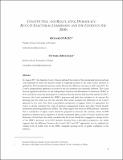Files in this item
Constituting and regulating democracy : Kenya’s electoral commission and the Courts in the 2010s
Item metadata
| dc.contributor.author | Stacey, Richard | |
| dc.contributor.author | Miyandazi, Victoria | |
| dc.date.accessioned | 2022-11-30T13:30:01Z | |
| dc.date.available | 2022-11-30T13:30:01Z | |
| dc.date.issued | 2021-12 | |
| dc.identifier | 281760595 | |
| dc.identifier | 04088ba9-58a4-4275-8231-1f677e08485d | |
| dc.identifier | 85120851935 | |
| dc.identifier.citation | Stacey , R & Miyandazi , V 2021 , ' Constituting and regulating democracy : Kenya’s electoral commission and the Courts in the 2010s ' , Asian Journal of Comparative law , vol. 16 , no. S1 , pp. S193 - S210 . https://doi.org/10.1017/asjcl.2021.36 | en |
| dc.identifier.issn | 1932-0205 | |
| dc.identifier.other | ORCID: /0000-0001-9124-7145/work/121312424 | |
| dc.identifier.uri | https://hdl.handle.net/10023/26518 | |
| dc.description.abstract | In August 2017, responding to a petition from the losing candidate in the presidential election held days before, the Supreme Court of Kenya declared the results of the election null and void. Dramatic in itself, the decision stands in surprising contrast to the same Court's decision to uphold the 2013 election results following a similar petition. Beyond the different outcomes in 2013 and 2017, the Court's jurisprudential approach to the two petitions was markedly different. The Court showed significant deference to the Independent Elections and Boundaries Commission (IEBC) in 2013, and did not seriously interrogate its conclusion that the election had been free and fair. In 2017, however, the Court scrutinised the IEBC's process and paid close attention to the reasons it gave for declaring the result free and fair. This article considers the difference in the Court's approach in two ways. First, from a prescriptive perspective, it suggests when it is appropriate for courts to closely scrutinise the work of elections management boards and other ‘fourth branch’ institutions protecting democracy (IPDs). The article argues that where an IPD performs a function that is constitutive of rights, courts should be prepared to intervene. By contrast, where an IPD performs a function that is regulative of already constituted rights, courts of review should act with deference. On this basis, the article concludes that the Court should have engaged in a deeper review of the IEBC's 2013 decision. Second, from a descriptive perspective, the article suggests that the difference between the Court's 2013 and 2017 approaches can be explained by waning levels of public trust in the IEBC alongside growing levels of public confidence in the judiciary. | |
| dc.format.extent | 18 | |
| dc.format.extent | 448121 | |
| dc.language.iso | eng | |
| dc.relation.ispartof | Asian Journal of Comparative law | en |
| dc.rights | Copyright © 2022 the Author(s). This work has been made available online in accordance with publisher policies or with permission. Permission for further reuse of this content should be sought from the publisher or the rights holder. This is the author created accepted manuscript following peer review and may differ slightly from the final published version. The final published version of this work is available at https://doi.org/10.1017/asjcl.2021.36. | en |
| dc.subject | Constitutional democracy | en |
| dc.subject | DT Africa | en |
| dc.subject | JF Political institutions (General) | en |
| dc.subject | T-NDAS | en |
| dc.subject | AC | en |
| dc.subject.lcc | DT | en |
| dc.subject.lcc | JF | en |
| dc.title | Constituting and regulating democracy : Kenya’s electoral commission and the Courts in the 2010s | en |
| dc.type | Journal article | en |
| dc.contributor.institution | University of St Andrews.School of History | en |
| dc.identifier.doi | 10.1017/asjcl.2021.36 | |
| dc.description.status | Peer reviewed | en |
This item appears in the following Collection(s)
Items in the St Andrews Research Repository are protected by copyright, with all rights reserved, unless otherwise indicated.

